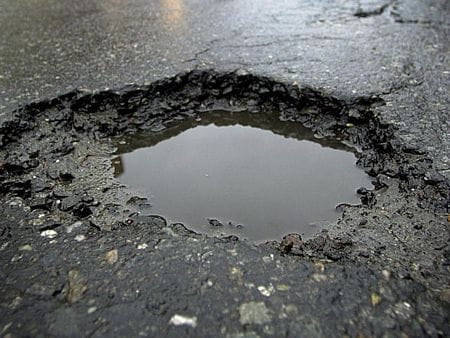Mid-season thaws can cause potholes to form in the road and lead to dangerous driving situations.

Living on the moon
First of all, if you live in Arizona, Texas, Florida or any other state that sees little or no freezing weather, you can stop reading right now. This is the time of year that anyone living in the northern climes really detests you anyway, so the fact that you're reading this is quite beside the point. But if you do happen to live in one of those states blessed (or cursed, depending upon your point-of-view) with the climate that inspired Richard B. Smith to write the ditty “Winter Wonderland”, read on.
Here at LotPro.com, discussions about potholes quickly turn defensive when we’re approached by someone who doesn’t live in Michigan or any of the other states subject to this particular form of infrastructure blight. For the record, potholes are not caused by some form of substandard road construction – and please don’t begin to lecture us on the need for better road maintenance. The road crews here in Southeastern Michigan – particularly Oakland County – are some of the best on the planet and work tirelessly in the winter, sometimes in around-the-clock shifts, to keep the roads of our fair state suitable for safe winter transport.
The root cause of potholes – the process that can turn an ordinary urban street into one that resembles nothing less than a lunar landscape of tire-splitting, wheel-bending craters – is nothing more than the abrupt change in ambient road temperature (freeze-thaw-freeze) coupled with the warming rays of the sun (which, contrary to popular opinion, is not completely absent from Michigan in the winter months – we just don’t see it very often).
How to build a pothole
Potholes are formed when pavement (either asphalt or concrete) ages and cracks form on the surface, allowing moisture to penetrate through the pavement to the underlying soil.
Here (according to the Michigan Department of Transportation) is how it works:

Pothole driving survival tips from Ford
Fortunately, the good folks at Ford Motor Company have come up with a “pothole survival guide” and we pass it on to you today:
DEARBORN, Mich., Dec. 31 – Winter driving isn't just about traveling safely on snow and ice. It's also about coping with potholes when mid-season thaws cause the road to crumble beneath your tires.
Damaged wheels and tires do not only leave motorists stranded at the side of the road, they can also leave their wallets empty.
It is worth noting that new Ford, Lincoln and Mercury vehicles are subject to some stringent testing that can help prevent damage caused by chuckholes. To validate its vehicle designs, Ford has several proving grounds, including those in Romeo, Mich., and Dearborn, Mich., which are filled with different types of carefully designed torture devices designed to test and improve the durability of the entire vehicle.
Ford engineers design parts up-front to handle these potholes in the road as effectively as possible, balancing them for numerous other customer driving conditions. To give drivers a fighting chance with monster potholes, engineers tune shock rebound rates to keep the wheel and tire suspended so it can glide over the pothole, preventing the tire from dropping down into it and impacting the edge of the tire and wheel.
Ford Motor Company has several tips for drivers to help prevent damage to their vehicles from potholes:
• Pay special attention to your tire pressure. Keeping tire pressure consistently at the manufacturer's recommendation will help protect your vehicle's wheels and tires from being damaged from pothole impacts.
• If safe, don't swerve to avoid potholes. Swerving can create a situation where the front wheel and tire on the car can impact the edge of the pothole at an obtuse angle, which might do more damage than hitting it squarely.
• If safe, don't brake just because you see a pothole: heavy braking compresses the front suspension of the car and will have a tendency to force the tire and wheel down into the pothole, instead of gliding over
No matter how carefully you drive there's always the possibility that you may eventually have a flat tire on the highway. Drive slowly to the closest safe area out of traffic. This may further damage the flat tire, but your safety is more important.
If you feel a sudden vibration or ride disturbance while driving, or you suspect your tire or vehicle has been damaged, immediately reduce your speed. Drive with caution until you can safely pull off the road. Stop and inspect the tires for damage. If a tire is under-inflated or damaged, deflate it, remove wheel and replace it with your spare tire and wheel. If you cannot detect a cause, have the vehicle towed to the nearest repair facility or tire dealer to have the vehicle inspected.












